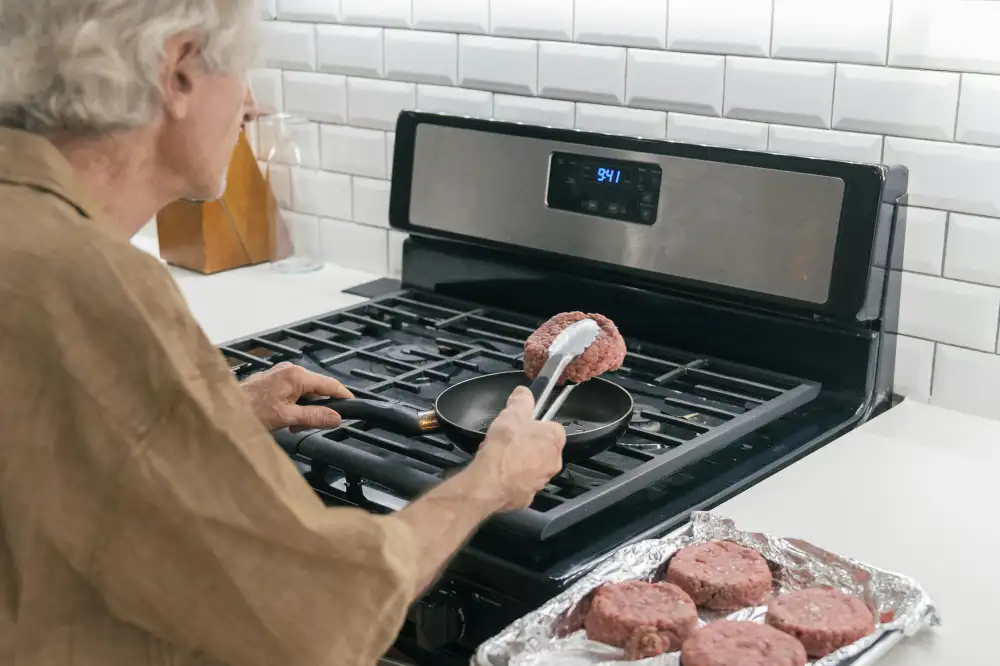The Perfect Burger: Mastering the Art of Cooking Burgers to Perfection

- Factors affecting cooking time:
- Thickness of the burger patty
- Desired level of doneness
- Cooking method (grilling, stovetop, oven)
- Recommended cooking times for burgers:
- Medium-rare: 3-4 minutes per side
- Medium: 4-5 minutes per side
- Medium-well: 5-6 minutes per side
- Well-done: 6-7 minutes per side
- Using a meat thermometer to ensure proper doneness:
- Inserting the thermometer into the thickest part of the patty
- Recommended internal temperatures for burgers
- Resting the burgers before serving:
- Allowing the juices to redistribute for better flavor and texture
- Resting time recommendations
Introduction: The Perfect Burger: Mastering the Art of Cooking Burgers to Perfection
Cooking burgers to the right temperature is crucial for both flavor and food safety. Undercooking can lead to potential health risks, while overcooking can result in dry and tasteless burgers. Achieving the perfect balance requires understanding the factors that affect cooking time and using a meat thermometer to ensure proper doneness. By mastering the art of cooking burgers to perfection, you can enjoy a delicious and safe meal every time.
Factors affecting cooking time:
The cooking time of a burger can be influenced by several factors. Firstly, the thickness of the patty plays a significant role. Thicker patties will require more time to cook through compared to thinner ones. Secondly, the desired level of doneness also affects the cooking time. A rare or medium-rare burger will take less time to cook than a well-done one. Lastly, the cooking method chosen will impact the cooking time as well. Grilling tends to be faster than stovetop or oven cooking. It is essential to consider these factors when determining the appropriate cooking time for your burgers.
Thickness of the burger patty
The thickness of the burger patty is a crucial factor in determining its cooking time. Thicker patties will take longer to cook compared to thinner ones. This is because heat needs to penetrate through the entire patty to ensure it is cooked evenly. For example, a 1-inch thick patty will require more cooking time than a 1/2-inch thick patty. It's important to consider the thickness of your burger when determining the cooking time to achieve the desired level of doneness.
Desired level of doneness
The desired level of doneness is a crucial factor in cooking burgers to perfection. It determines the internal temperature and texture of the patty. For a medium-rare burger, cook it for 3-4 minutes per side, resulting in a pink and juicy center. If you prefer a medium burger with a slightly pink center, cook it for 4-5 minutes per side. For a medium-well burger with only a hint of pink, cook it for 5-6 minutes per side. And if you like your burger well-done with no pink at all, cook it for 6-7 minutes per side. Adjusting the cooking time according to your desired level of doneness will ensure that your burger is cooked just the way you like it.
Cooking method (grilling, stovetop, oven)
The cooking method you choose can greatly affect the cooking time and overall flavor of your burger. Grilling is a popular choice, as it imparts a smoky flavor and creates those coveted grill marks. On a preheated grill, cook each side of the burger for about 3-4 minutes for medium-rare, 4-5 minutes for medium, 5-6 minutes for medium-well, and 6-7 minutes for well-done.
If grilling isn't an option, stovetop cooking is another great method. Heat a skillet over medium-high heat and cook each side of the burger for similar times as grilling.
Alternatively, you can also cook burgers in the oven. Preheat the oven to 400°F (200°C) and place the burgers on a baking sheet lined with parchment paper. Cook them for about 10-12 minutes per side for medium-rare to medium doneness.
Remember that these times are just guidelines and may vary depending on factors like patty thickness and desired level of doneness. It's always best to use a meat thermometer to ensure your burger reaches the right internal temperature for safety and optimal taste.
Recommended cooking times for burgers:
Recommended cooking times for burgers vary depending on the desired level of doneness. For a medium-rare burger, cook each side for about 3-4 minutes. If you prefer a medium burger, increase the cooking time to around 4-5 minutes per side. For a medium-well burger, aim for 5-6 minutes per side. And if you like your burger well-done, cook it for approximately 6-7 minutes per side. These cooking times are based on using a stovetop or grill at medium-high heat. Remember to adjust the cooking time accordingly if using an oven or other cooking methods.
Medium-rare: 3-4 minutes per side
When it comes to cooking the perfect burger, achieving the desired level of doneness is crucial. For those who prefer a medium-rare burger, the recommended cooking time is 3-4 minutes per side. This allows for a juicy and slightly pink center while ensuring that the patty is cooked through. The actual cooking time may vary depending on factors such as the thickness of the patty and the cooking method used. It's important to keep an eye on the burger and adjust the cooking time accordingly to avoid overcooking. By following these guidelines, you can savor a mouthwatering medium-rare burger that is both flavorful and safe to eat.
Medium: 4-5 minutes per side
When cooking a burger to a medium level of doneness, it is recommended to cook each side for about 4-5 minutes. This cooking time will ensure that the burger is cooked through but still retains some pinkness in the center. The exact cooking time may vary depending on factors such as the thickness of the patty and the cooking method used. Thicker patties will require slightly longer cooking times, while thinner patties may cook faster. It is important to monitor the burger closely to avoid overcooking or undercooking. Using a meat thermometer can help ensure that the burger reaches the desired internal temperature.
Medium-well: 5-6 minutes per side
When it comes to cooking a medium-well burger, timing is crucial. To achieve the perfect balance of juiciness and doneness, you'll want to cook each side for approximately 5-6 minutes. This cooking time allows the patty to develop a slightly pink center while ensuring that it is cooked through.
However, it's important to note that the cooking time may vary depending on factors such as the thickness of the patty and the cooking method used. Thicker patties will require more time, while thinner ones will cook faster.
To ensure that your medium-well burger is cooked to perfection, it's recommended to use a meat thermometer. Insert the thermometer into the thickest part of the patty without touching any bones or gristle. The internal temperature should reach 150-155°F (65-68°C) for medium-well doneness.
By following these guidelines, you can enjoy a flavorful and safe medium-well burger that satisfies your taste buds. Remember, cooking times are just estimates, so always rely on a meat thermometer for accurate results.
Well-done: 6-7 minutes per side
When cooking a burger to well-done, it is important to ensure that it reaches a safe internal temperature while still maintaining juiciness. This level of doneness typically requires cooking the patty for 6-7 minutes per side. However, factors such as patty thickness and cooking method may slightly alter the cooking time.
To guarantee that your well-done burger is cooked to perfection, it is recommended to use a meat thermometer. Insert the thermometer into the thickest part of the patty without touching the grill or pan. The internal temperature should reach 160°F (71°C) for ground beef to be considered safe to consume.
By following these guidelines, you can enjoy a delicious and safe well-done burger. Remember, proper cooking times and temperatures are crucial not only for taste but also for food safety.
Using a meat thermometer to ensure proper doneness:
Using a meat thermometer is the most accurate way to ensure that your burgers are cooked to the proper doneness. To use a meat thermometer, insert it into the thickest part of the patty, making sure not to touch the bone or any fat. For medium-rare burgers, the internal temperature should reach 135°F (57°C). Medium burgers should be cooked to 145°F (63°C), while medium-well burgers should reach 160°F (71°C). Well-done burgers should have an internal temperature of 165°F (74°C). Remember to clean your thermometer after each use to prevent cross-contamination.
Inserting the thermometer into the thickest part of the patty
Using a meat thermometer is the most accurate way to ensure that your burgers are cooked to the right temperature. To do this, insert the thermometer into the thickest part of the patty, making sure not to touch any bones or gristle. This will give you an accurate reading of the internal temperature of the burger. It is important to note that different levels of doneness have different recommended internal temperatures. For example, a medium-rare burger should have an internal temperature of 130-135°F (54-57°C), while a well-done burger should reach 160°F (71°C). By using a meat thermometer, you can be confident that your burgers are cooked safely and to perfection.
Recommended internal temperatures for burgers
4. Using a meat thermometer to ensure proper doneness:
a. Inserting the thermometer into the thickest part of the patty
b. Recommended internal temperatures for burgers
To ensure that your burgers are cooked to perfection, it is essential to use a meat thermometer. Insert the thermometer into the thickest part of the patty, making sure not to touch any bones or gristle. This will give you an accurate reading of the internal temperature.
For medium-rare burgers, aim for an internal temperature of 130-135°F (55-57°C). This will result in a juicy and slightly pink center. If you prefer your burger medium, cook it until it reaches 140-145°F (60-63°C). Medium-well burgers should have an internal temperature of 150-155°F (65-68°C), while well-done burgers should reach 160°F (71°C) or higher.
Remember that these temperatures are just guidelines and personal preferences may vary. It is important to cook ground meat thoroughly to reduce the risk of foodborne illnesses. Using a meat thermometer ensures that your burgers are not only delicious but also safe to eat.
Resting the burgers before serving:
Resting the burgers before serving is an essential step in achieving a delicious and flavorful meal. When burgers are cooked, the heat causes the juices to move towards the center of the patty. By allowing the burgers to rest for a few minutes, these juices have time to redistribute throughout the patty, resulting in a juicier and more flavorful burger.
The recommended resting time for burgers is about 5 minutes. During this time, you can cover them loosely with foil to keep them warm. This short resting period allows the proteins in the meat to relax and reabsorb some of the moisture that was lost during cooking.
Resting also helps to ensure that your burger is safe to eat. It gives any remaining bacteria on the surface of the meat a chance to be destroyed by the residual heat. This is especially important if you prefer your burger cooked medium-rare or medium, as it ensures that any potential harmful bacteria are eliminated.
So, resist the temptation to dig into your perfectly cooked burger right away. Give it a few minutes to rest and allow those flavors to meld together. Your taste buds will thank you!
Allowing the juices to redistribute for better flavor and texture
Allowing the juices to redistribute after cooking is a crucial step in achieving a burger with optimal flavor and texture. When burgers are cooked, the heat causes the juices to move towards the center of the patty. By allowing the burgers to rest for a few minutes before serving, these juices have time to redistribute throughout the patty, resulting in a more evenly moist and flavorful burger. Resting also allows the proteins in the meat to relax, making for a tender and juicy bite. For best results, let your burgers rest for about 5 minutes before serving. This simple step will elevate your burger game and ensure a delicious dining experience.
Resting time recommendations
Resting the burgers before serving is an essential step in achieving the perfect burger. This allows the juices to redistribute, resulting in a more flavorful and tender patty. The recommended resting time for burgers is about 5 minutes. During this time, cover the burgers loosely with foil to keep them warm. This resting period also allows the internal temperature of the burger to continue rising slightly, ensuring that it reaches the desired level of doneness. So, resist the temptation to dig in right away and give your burgers a few minutes to rest before enjoying them.
In conclusion, mastering the art of cooking burgers to perfection is essential for a delicious and safe meal. By understanding the factors that affect cooking time, such as patty thickness, desired level of doneness, and cooking method, you can achieve the perfect burger every time. Following the recommended cooking times for each level of doneness ensures that your burger is cooked to your preference. Using a meat thermometer to check the internal temperature guarantees that your burger is safe to eat. Resting the burgers before serving allows the juices to redistribute, resulting in better flavor and texture. So next time you fire up the grill or heat up the stovetop, remember these tips and enjoy a mouthwatering burger that will impress your taste buds!
Published: 11. 02. 2024
Category: Recipes



